Choosing a paint color can totally change how your space feels. Ever noticed how a color looks amazing in one room but just “off” in another? That’s usually because of the way natural light shifts depending on which direction your room faces.
Remember to repin your favorite images!
Your room’s direction actually changes how light enters and dramatically affects how paint colors show up on your walls.
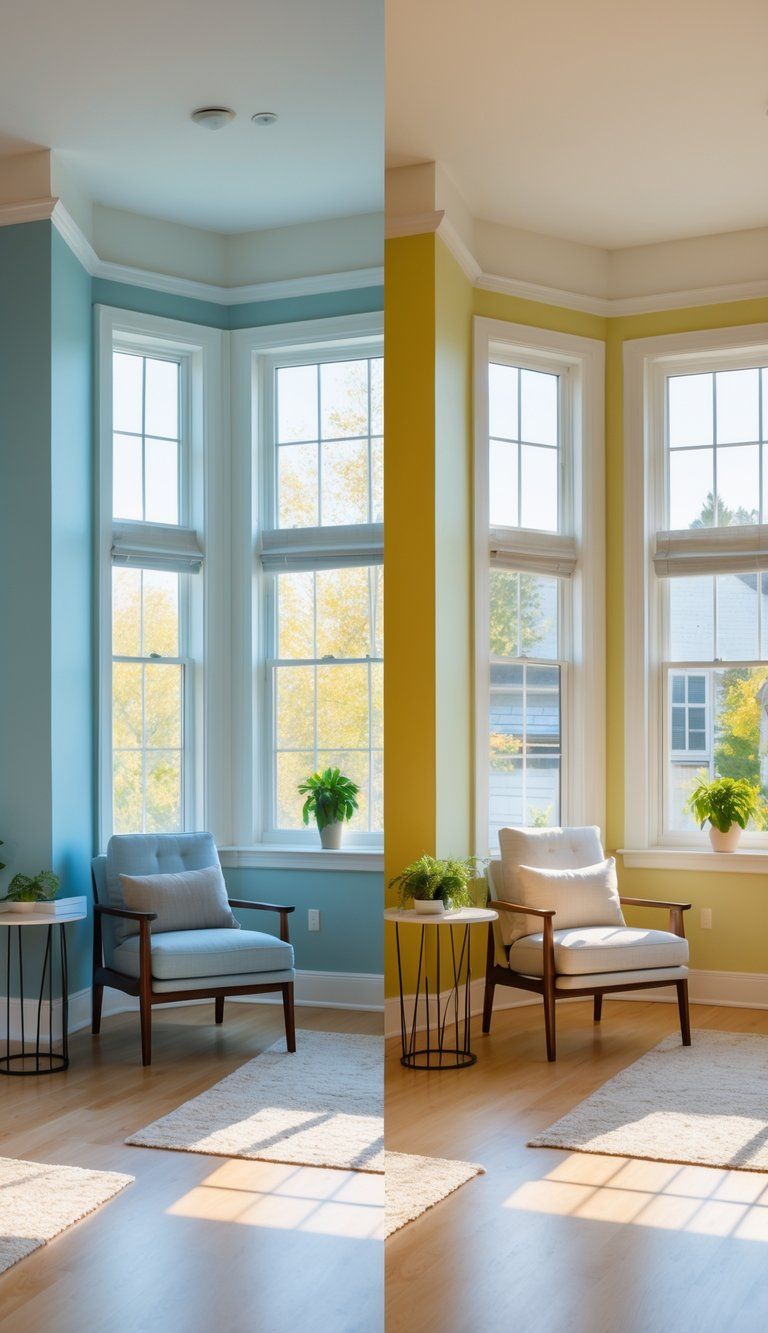
North-facing rooms barely get any direct sunlight, so they often feel cooler and a bit dark. If you want to make these spaces cozier, warm colors like soft ochre or creamy neutrals can really help.
South-facing rooms, on the other hand, soak up loads of warm light. This gives you more freedom with color, but sometimes very warm shades can be a bit much.
East and west-facing rooms are a whole different story. Their light changes a ton during the day. East-facing rooms start off with bright yellow morning light, then shift cooler as the day goes on.
West-facing rooms begin with cooler light and then get hit with that golden afternoon sun. If you understand these patterns, you’ll have a much easier time picking colors that look great all day long.
Understanding Room Orientation and Light Exposure
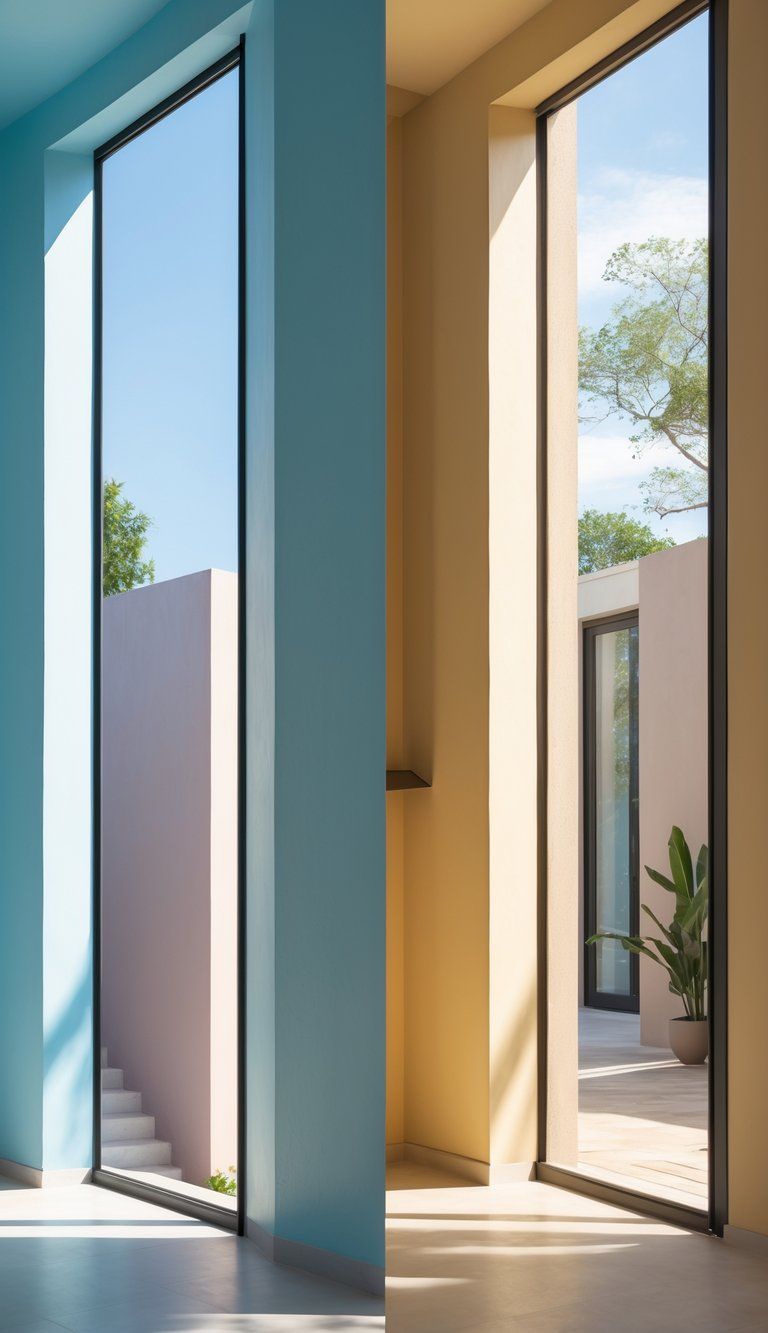
Room orientation really impacts how colors look. The direction of your windows controls the type and strength of natural light, and that can totally change your paint’s appearance.
The Science of Natural Light
Natural light shifts based on which way your room faces and what time it is. North-facing rooms get indirect, cool light that stays pretty steady, but it’s not very strong.
This kind of light can make colors look dull or grayer than you’d expect. South-facing rooms, though, get direct sun for most of the day, so things look warmer and brighter.
Colors in these rooms usually pop more and feel warmer. East-facing spaces get that lovely warm morning light, but by afternoon it cools down.
West-facing rooms do the reverse—they start cool and get that golden glow in the afternoon. This late-day light can make colors look richer as the sun sets.
How Light Exposure Influences Color Perception
Light quality can totally change how you see paint colors. Cool northern light pulls out blue and green undertones, while southern light boosts yellows, reds, and oranges.
Paints with red, yellow, or orange undertones will look extra lively in south and west-facing rooms. In north-facing rooms, these warmer shades help fight off the chilliness.
Blues, greens, and cool grays can look a little flat in northern light. If you love them, try picking warmer versions for north-facing rooms.
Color Temperature Guide for Room Exposure:
- North: Go for warm, yellow-based neutrals or rich, saturated shades
- South: Almost anything works; cool tones help balance out the bright light
- East: Pick colors that look good in both warm and cool light
- West: Think about how your color will look in that golden evening sun
The Role of Artificial Lighting
Artificial lighting can totally change color perception. The bulbs you use matter just as much as the paint.
Types of artificial lighting and their effects:
- Incandescent: Adds a warm, yellow glow—great for making warm colors pop
- LED: Comes in lots of color temperatures, from warm to cool
- Fluorescent: Tends to be cooler, which can dull warm paint colors
- Halogen: Mimics daylight best and shows colors most accurately
When you test paint, look at it in both daylight and your room’s artificial light. You’ll probably notice the color shifts a bit as the day goes on.
Try to pick bulbs that complement your room’s natural light. In north-facing rooms, warmer bulbs (2700-3000K) can help cozy things up. In bright south-facing spaces, cooler bulbs (3500-4100K) might actually feel more comfortable.
Key Paint Color Principles for Every Room
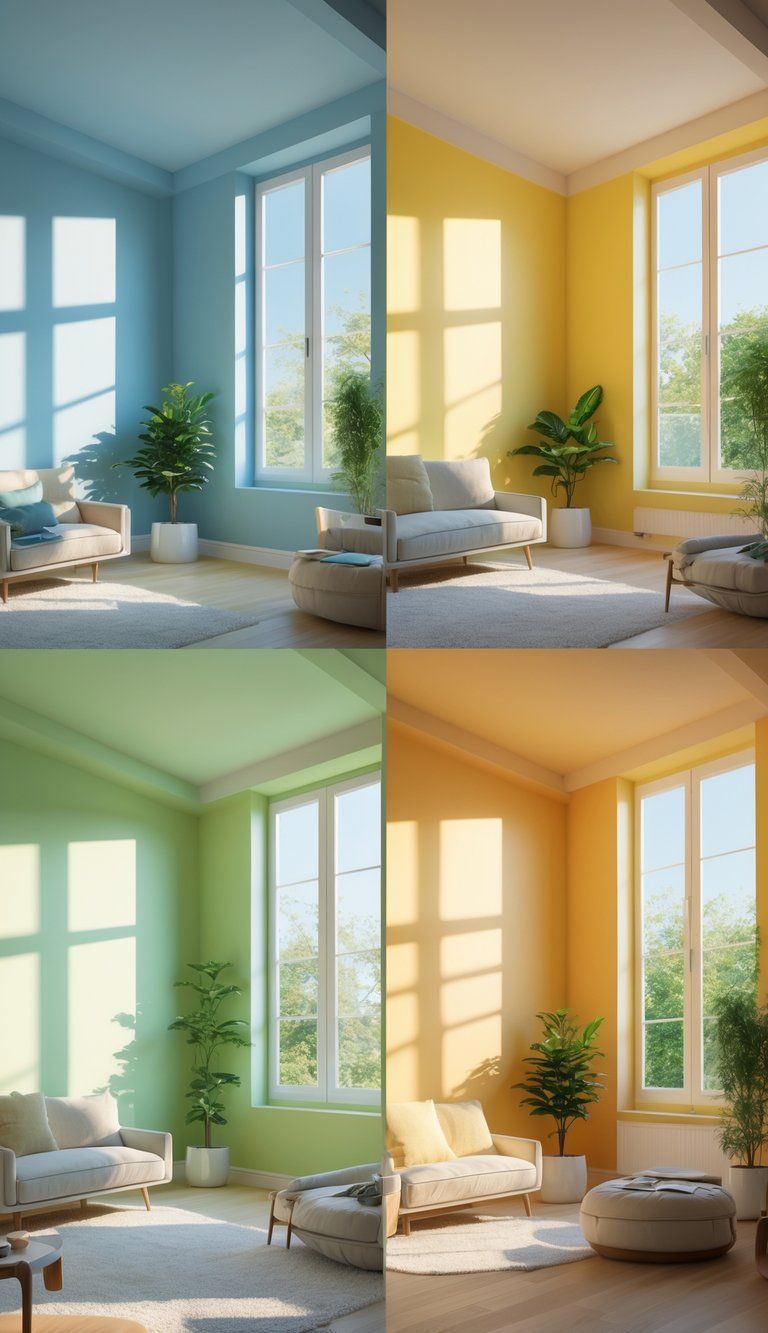
Picking paint isn’t just about grabbing a color you like. Light bounces off your walls in different ways depending on which way your windows face and the time of day.
Warm and Cool Undertones Explained
You’ve got to pay attention to undertones when choosing paint. Undertones are those sneaky hints of color hiding beneath what you see.
Warm undertones—think reds, oranges, yellows—make rooms feel inviting, even energetic. They’re especially helpful in north-facing rooms that need a little brightening up.
Cool undertones—blues, greens, purples—give off a calm, airy vibe. They’re awesome for south-facing rooms that might already feel warm.
To spot undertones, hold your paint sample against a pure white background. Suddenly, those hidden hues jump out. The color wheel can help too—opposites either complement or cancel each other.
How Paint Samples Improve Color Selection
Never skip the sample stage. Paint colors can look wildly different depending on the light in your room.
Grab a few sample pots or those peel-and-stick samples from Samplize. Slap them on a few walls and check them out at different times of day.
For better results:
- Put samples at eye level
- Look at them in both daylight and your regular lighting
- Check them in the morning, afternoon, and evening
- See how they work with your floors and furniture
Light can make paint look three shades lighter or darker. What looks perfect at the store might feel way off at home.
Testing a few samples side by side helps you spot those subtle undertones. It’s a small step that saves you from a big headache later.
Best Paint Colors for North-Facing Rooms
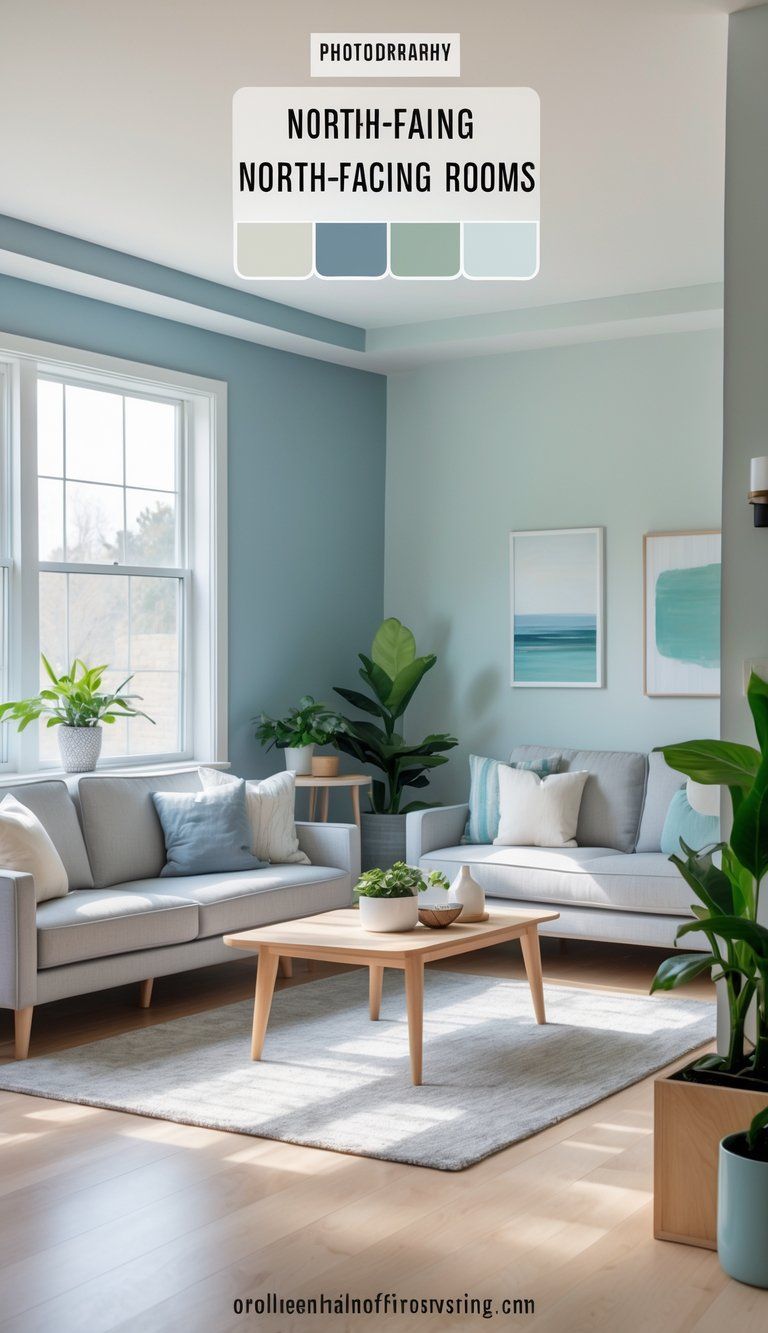
North-facing rooms can be tricky because the light is cool and a bit blue-tinted. But the right paint colors can turn these spaces into warm, inviting spots.
Embracing Warm Paint Colors
Warm shades really shine in north-facing rooms. Try yellow-based colors like Benjamin Moore’s “Antique White” for a subtle lift.
Sherwin Williams “Greek Villa” adds a creamy touch that brightens things up and keeps the vibe cozy. This one balances out that chilly northern light.
If you want more color, you might like:
- Terra cotta
- Soft coral
- Muted gold
- Gentle amber
These shades bounce what little light you get around the room, making everything feel brighter and friendlier. North-facing rooms tend to make colors look a bit cooler, so keep that in mind.
Neutral and Light Options
Warm neutrals are super versatile for north-facing spaces. Sherwin Williams “Worldly Gray” is a warm gray that doesn’t fall flat in dim light.
When picking neutrals, look for:
- Yellow undertones (to fight the blue light)
- A bit of beige (for extra warmth)
- Soft sand vibes (to help things feel lighter)
Pure whites usually look dull or even a little blue in these rooms. Stick with off-whites that have creamy or ivory undertones—they’ll read as “true white” in northern light.
Light reflectance value (LRV) matters too. Higher LRV colors help you squeeze every bit of brightness out of the space.
Accentuating With Warm Undertones
The trick with north-facing rooms is all about the undertones. Even a small hint of gold, red, or yellow can make a big difference.
Earthy undertones help ground the space and make it feel welcoming. You don’t need them to be obvious—even a little warmth helps.
For trim and ceilings, try:
- Creamy whites, not stark ones
- Matching the undertones to your wall color
- Going a touch warmer than you might elsewhere
Test your samples at different times of day. North-facing rooms change a lot from morning to night, and you want a color that feels good all day.
Perfect Paint Colors for South-Facing Rooms
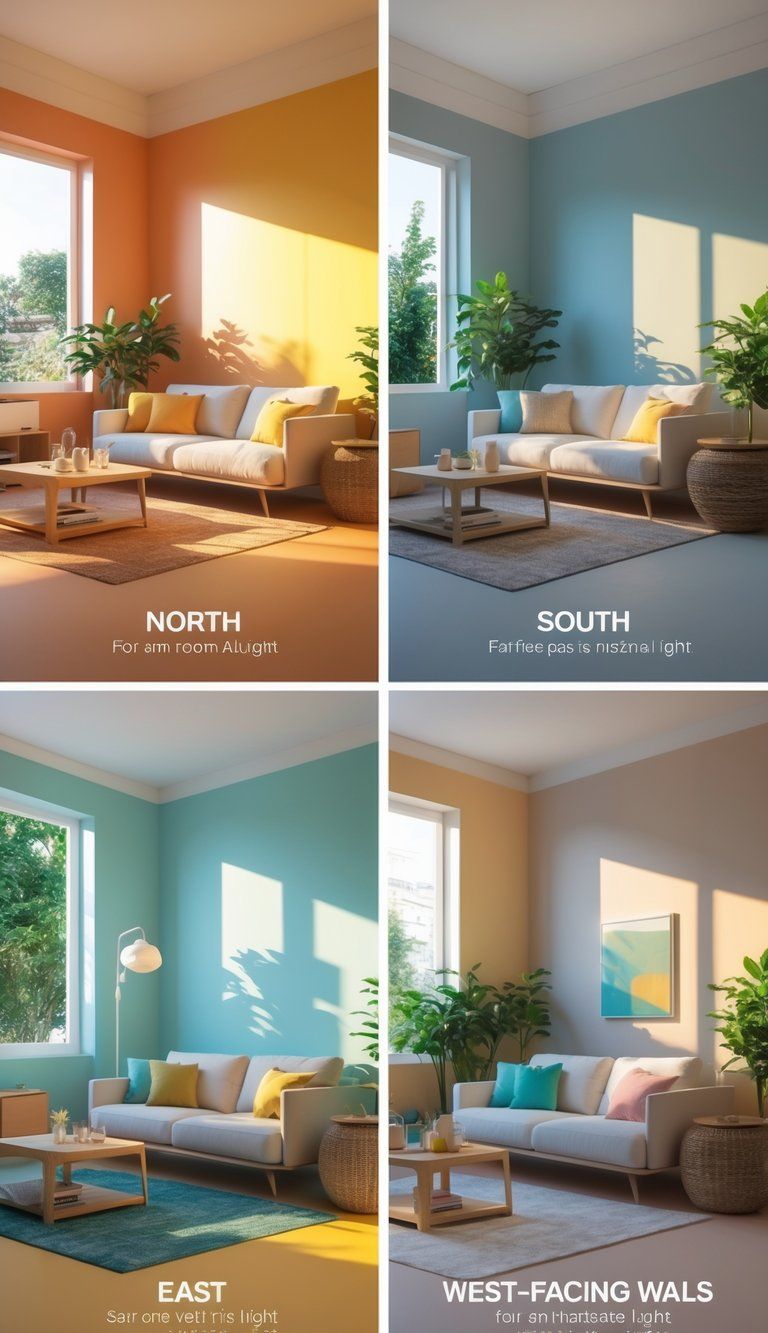
South-facing rooms bask in warm, yellow-toned light all day long. At midday, that light can get so strong it washes colors out.
Maintaining Brightness With Pale Neutrals
Pale neutrals are a solid choice for south-facing spaces. They balance out the warmth without feeling too intense.
Cool whites like Benjamin Moore’s “Chantilly Lace” or “Decorator’s White” can help tone down those yellow highlights.
Gray paints with blue undertones—like Sherwin Williams “Repose Gray” or Benjamin Moore “Stonington Gray”—also work well for a balanced, not-too-warm look.
Watch out for pure whites, though. They can look harsh and almost clinical in bright southern light. Whites with a whisper of gray tend to feel softer.
Colors will shift throughout the day in these rooms, so test samples on a couple of walls and check them at different times before you commit.
Harnessing Warm Light Effectively
You can work with the warm light by picking colors that complement it, not fight it. Soft blues and greens make a fresh contrast to all that yellow without clashing.
Try Benjamin Moore’s “Palladian Blue” or Sherwin Williams’ “Sea Salt” for a calm, bright vibe. These cooler colors balance the warmth but don’t make things feel chilly.
If you want something bold, deep navy or charcoal can add drama and soak up some of that strong light. Benjamin Moore’s “Hale Navy” is a classic for this.
Avoid creamy or yellow-based neutrals—they can end up looking way too yellow in southern light. Neutrals with blue or violet undertones are a safer bet for balance.
Ideal Paint Colors for East-Facing Rooms
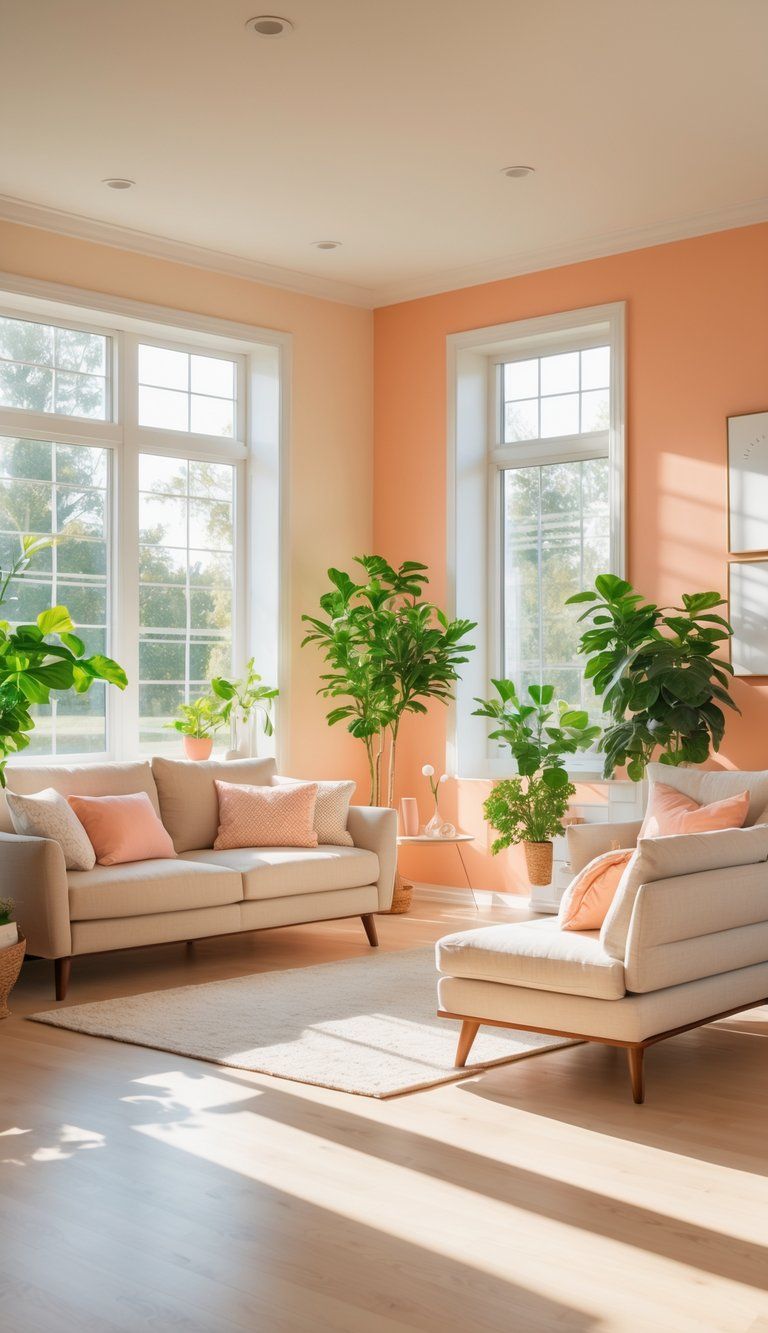
East-facing rooms get that gorgeous morning sun, but by afternoon, things can cool off and feel a bit dim. The right paints will help you keep the glow in the morning and hold onto brightness later.
Maximizing Natural Morning Light
East-facing rooms soak up warm, golden light early in the day. Colors that love this kind of light really shine here. Light blues like Benjamin Moore’s “Morning Sky Blue” look crisp and fresh at sunrise.
Neutrals with warm undertones also do well. “Pale Oak” or “Manchester Tan” keep things warm even as the light fades.
If you want a white, Benjamin Moore’s Chantilly Lace OC-65 is a great pick. It’s clean and bright—no yellow undertones to muddy things up in the afternoon.
Best Morning Light Enhancers:
- Soft corals or peachy shades
- Warm beiges and tans
- Clear, light blues
- Crisp whites (skip the yellow undertones)
Adapting to Changing Light Throughout the Day
As the day goes on, east-facing rooms lose that direct sun and can look cooler or even a little gray. Pick paints that don’t get drab as the light shifts.
Medium neutrals with warm undertones stay pretty consistent. “Balanced Beige” or “Accessible Beige” keep things from feeling flat in the afternoon.
If you’re drawn to cooler colors, find ones with just a hint of warmth. “Sea Salt” and “Palladian Blue” are good bets—they hold up as the light changes.
Tips for Light Transition:
- Test samples at different times of day
- Steer clear of very cool grays and blues that might get dreary later
- Think about extra lighting for the evening when the room is at its darkest
Selecting Paint Colors for West-Facing Rooms
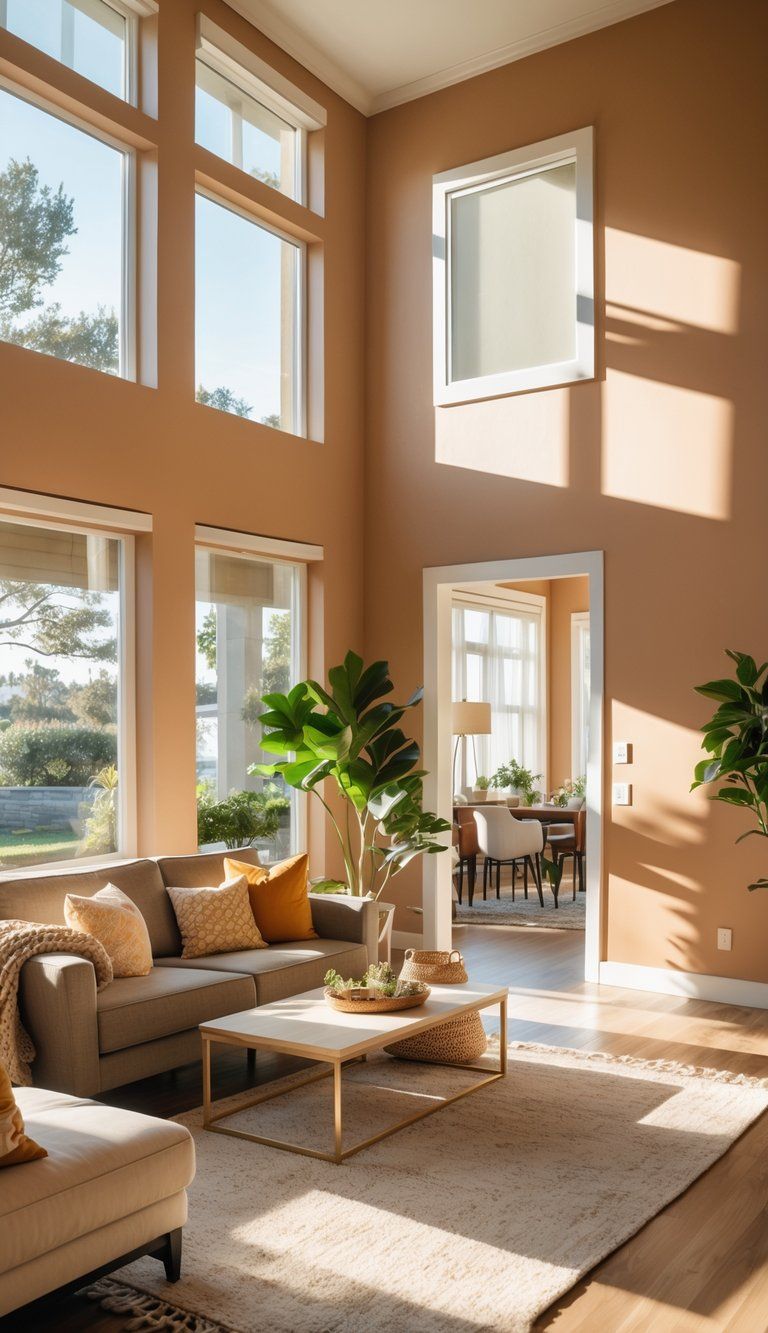
West-facing rooms get some pretty unique lighting shifts as the day goes on. Mornings start off with cooler, softer light, but by afternoon and evening, the sunlight turns warm and intense.
Balancing Warm Western Exposure
Afternoons in west-facing rooms can get seriously golden. That warm light makes any warm paint color look even bolder—sometimes more than you bargained for.
If you want to balance that glow, cooler paint colors are your friend. Light blues, gentle greens, and certain grays can really help tone things down later in the day.
I like Benjamin Moore’s “Stormy Monday” or “Gray Owl” for these spaces. Those grays stay balanced even as the light shifts. They don’t feel chilly in the morning, but they do a nice job of keeping the afternoon heat in check.
Best morning colors for west rooms:
- Slightly warmer neutrals
- Mid-tone blues and greens
- Soft lavenders
Choosing the Right Shade for Afternoon Light
Afternoon light in these rooms can be a real game-changer for your paint color. You need something that looks good in both the gentle morning and the fiery afternoon.
Beige shades like “Manchester Tan” or “Pale Oak” work nicely. They feel warm and cozy in the morning but don’t get too wild in the afternoon sun. These versatile neutrals seem to handle the light changes well.
If you want some color, try muted versions instead of bright, saturated ones. A muted sage green is way more forgiving than a bold emerald once the sun hits.
Light behavior in west rooms:
- Morning: Cooler, indirect light
- Afternoon: Gradually warming
- Evening: Strong golden-hour glow
Mitigating Intense Warm Undertones
That golden afternoon light can really pull out warm undertones you didn’t even know were there. A color that looks neutral at the store might suddenly look yellow or orange once the sun streams in.
To keep things balanced, pick paints with subtle cool undertones. These colors look nice and steady in the morning and don’t turn too warm later.
Sherwin Williams “Repose Gray” or “Sea Salt” are solid choices. Their cool undertones help balance the warm artificial light you might use in the evenings, too.
When you test paint samples, put them on different walls and check them at various times. You might love a color at noon but find it too much by 5 PM. It’s honestly worth the effort in west-facing rooms because the light changes so dramatically.
Comparing Neutral Paint Colors Across Room Orientations
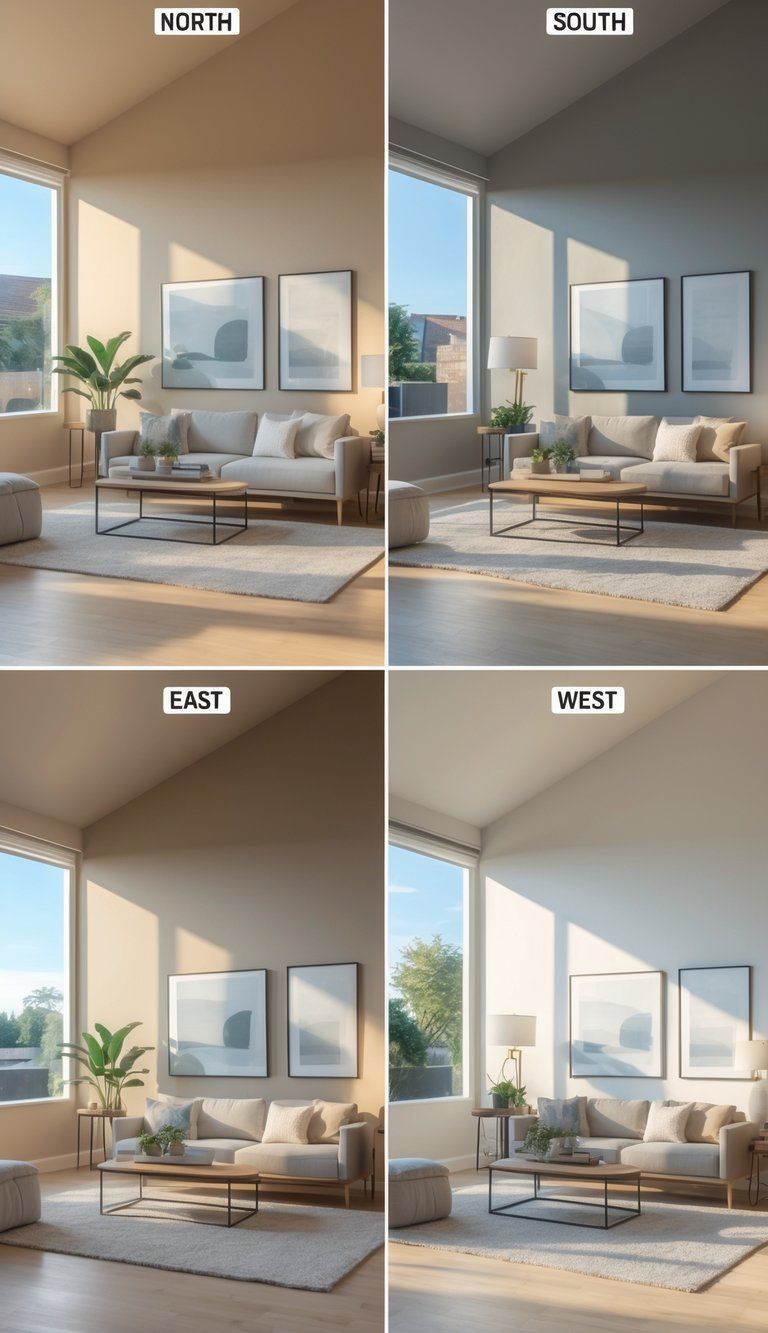
Neutral paint colors can look totally different depending on which way your windows face. The same beige that feels cozy in a south-facing room can look kind of flat and cold in a north-facing one.
Beige, Gray, and White Paint Color Considerations
Beige really shines in north-facing rooms if it has yellow or golden undertones to warm up the cool, blue-ish light. In south-facing rooms, though, beiges with pink undertones can get a bit too warm, so you’ll want to be careful there.
Gray paint colors act differently depending on the orientation:
- North-facing rooms: Go for warm grays (greige) with yellow undertones
- South-facing rooms: Cool grays with blue undertones help balance all that sunlight
- East-facing rooms: Both warm and cool grays can work, depending on when you use the space
- West-facing rooms: Grays with violet undertones help handle the strong afternoon light
White paint isn’t all the same. Bright whites look harsh in north-facing rooms, but creamy whites with yellow undertones add some needed warmth. In south-facing spaces, crisp whites with a hint of blue keep things from feeling too hot.
When to Use Warm vs. Cool Neutrals
Warm neutrals—think yellow, red, or orange undertones—make rooms feel cozy and energetic. North-facing rooms especially benefit from warm neutrals like caramel beige or golden tan to balance out the cool light.
Cool neutrals do best in spaces flooded with sunlight. South- and west-facing rooms usually look best with cool greiges or soft blue-tinted whites to keep the afternoon warmth in check.
Consider when you use each room. East-facing bedrooms feel great with warm neutrals since the morning light is already crisp. For west-facing dining rooms you use at night, cool neutrals help offset that intense sunset glow.
Dark neutrals can work in any direction if you use them thoughtfully. They create a cozy vibe in north-facing rooms but might look even darker than you expect. In bright south-facing rooms, dark neutrals keep their richness without feeling gloomy.
Expert Tips for Choosing the Perfect Paint Color
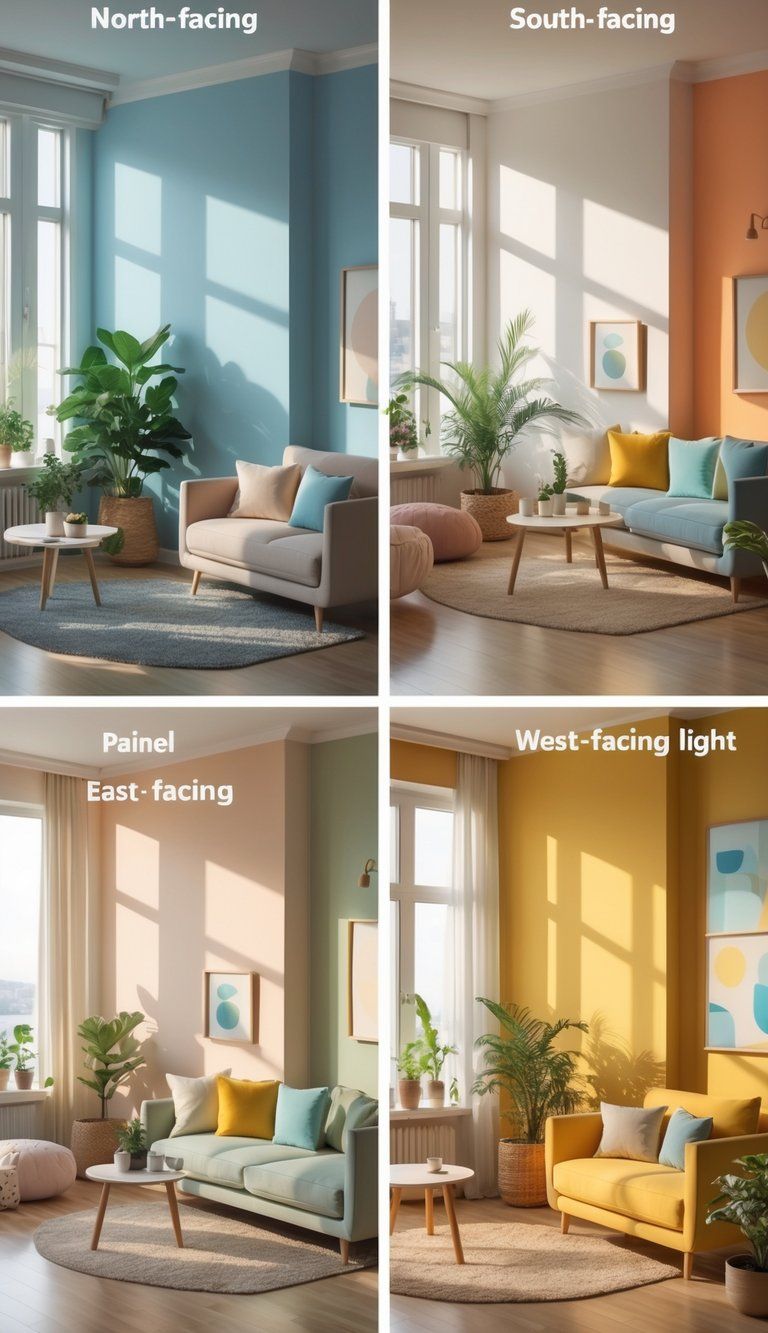
Picking the right paint color isn’t just about grabbing a shade you like. You really need to know how light plays with color and how to test colors in your own space.
Using Paint Samples Strategically
Always paint samples straight onto your walls. Don’t trust those tiny color cards—they’re just not enough. Paint at least a 2×2 foot square of each color you’re considering. That bigger patch will give you a much better sense of what you’re getting.
Check those samples at different times of day. Morning, afternoon, and evening light can make the same color look totally different, especially in east and west-facing rooms. What looks perfect at 10 AM might turn weird at 4 PM.
Move your samples around the room. A color will shift on a wall that gets direct sun compared to one in shadow.
Peel-and-stick paint samples are a great option, too. They’re less messy and you can move them to different spots as you test.
Adapting Colors to Interior Design and Finishes
Let your existing finishes guide your paint color selection. Wood tones, floors, countertops, and big furniture pieces all have undertones that need to work with your paint.
Watch out for undertones in your paint. Beige might have pink, yellow, or green hints that could clash with the rest of your stuff if you’re not careful.
Think about your home’s overall style. Traditional homes often look best with warmer colors, while modern spaces can handle cooler tones or bold accents.
Your lighting fixtures matter, too. Warm bulbs (2700-3000K) make reds and yellows pop, while cool bulbs (3500-4100K) highlight blues and greens.
Test your paint samples near permanent fixtures like cabinets, tile, and flooring to make sure everything feels right together.
How to Adjust for Variable Lighting in Multi-Exposure Rooms

Rooms with windows on more than one wall get tricky with all the shifting light. You’ll need thoughtful paint selection to keep things looking good as the light changes throughout the day.
Color Strategies for Three-Exposure Spaces
If you’ve got a room with windows on three different walls, you’re juggling a lot of shifting light. First, figure out which directions your windows face—north, south, east, or west. That combo really affects how the room feels.
Rooms with south, east, and west exposures get tons of daylight, but the vibe changes as the sun moves. Mornings start soft and warm from the east. Around midday, the southern sun pours in, making things extra bright. By afternoon, that western light gets golden and pretty intense.
I’d go for mid-tone colors here. Those shades won’t get lost in all that brightness, but they also don’t turn gloomy in the shadows.
North-facing windows add a cooler, grayish light. If your room includes a north window, try warmer paint—maybe a soft beige or a creamy yellow. It helps balance out the chillier feel.
Before you commit, slap some paint samples on different walls. Seriously, what looks perfect on an east wall can turn weirdly bold on the west side.
You’ll want to manage all those changing light conditions, too. Adjustable window treatments like sheer curtains or blinds are a lifesaver. They let you tone down that harsh afternoon sun without blocking the gentle morning light.

